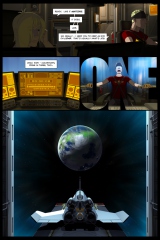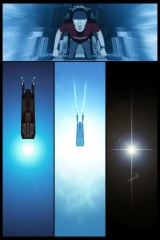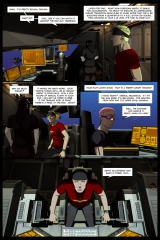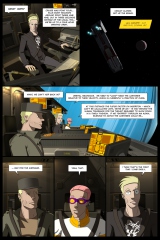A jumpnet is an alloy mesh that surrounds a spacecraft like a Faraday cage. A Navigator in physical or very close proximity to a jumpnet can transition a spacecraft into or out of Am.
The field amplification effect of the jumpnet medium extends the HRV of any entity that makes contact with it – while this has a profound, civilization-defining benefit for Navigators, contact with a jumpnet mesh also boosts the abilities of telepaths and remote viewers.
Traditionally, a jumpnet is built into the hull of a vehicle, with the navigation console being the sole point from which a Navigator can complete the “jump circuit.” In a pinch, any material close to the composition of jumpnet alloy will work, so long as the mesh covers a broad enough area. There have been several documented cases of stranded crews stripping or smelting larger vehicles and wrapping the salvaged material around the exterior of a smaller spaceworthy vehicle, the spacesuit-clad Navigator “riding” the craft into Am and off to safety. Similar nets are used in the freight industry to greatly expand the FTL transfer capacity of cargo vessels, and spacesuit gauntlets with jumpnet alloy pads built into the palms are readily available in most markets.
Tactically, a jumpnet must form a complete “sphere” or “field” around a starship – otherwise, the Navigator will not be able to Transition the encased vehicle into Am. Any breaks in the medium will render the net useless to a Navigator – in order to disable a ship’s FTL capability, all an opponent needs to do is knock a big enough hole in the hull. Space warfare and jumpnet vulnerability has had a marked influence on shipbuilding trends – often, the jumpnet of a military vessel is the most heavily armored and reinforced portion of the hull. In some cases, the jumpnet is more fortified than the crew compartments, weapons stores, engines, and fuel tanks.
In combat, jumpnet integrity is traditionally valued above life support integrity – while the crew can put on space suits, FTL ability can’t. Hull breaches can be patched in Am just as easily as they can be in outside of it. Conversely, unless a jumpnet-damaging breach occurs inside Am, the net must be viable for entry to be possible to begin with.
If the jumpnet is damanged in Am an “at will” exit is not possible, as such an action would require contact with a complete jump circuit. A Mass Influenced Transition – a Prime Insertion forced by the gravitational influence of a planet, star, moon, or any Prime body with a mass greater than the vehicle in question – is still possible.
Economically, the jumpnet medium is typically the most expensive single component of a starship. As the surface area of the net increases with the surface area of the starship, medium price has long been a limiting factor on the scale of large ships, and its inclusion has long been considered a luxury in smaller, “menial” vehicles such as the U-238. The “literal” jumpnets mentioned above are a relatively recent innovation, and most of them are forged from the nets of salvaged spacecraft – salvaged medium is easily forged into chains, yet refinement back to a quality rated for inclusion in a starship’s hull and life support systems is tedious, expensive, and typically more expensive than refining the medium from its constituent ores.
Until the development of the BTS, a Navigator and a jumpnet were the only means of traveling through Am – effectively making the combination the only means of non-relativistic FTL travel. While the BTS is faster in almost every instance, its size, cost, and Mass Displacement requirements mean there is no shortage of work for Navigators – and likely won’t be for at least three or four generations, by Heirotus estimates.
Jumpnets are optional on BTS equipped ships, as the system generates a field similar to that generated by a Navigator, on a relative scale. The difference is that the BTS field envelopes the ship entirely, without requiring a jumpnet. Which is yet another reason the Sabrosa gets stuck in Earth orbit – though it’s never mentioned explicitly, the ship almost certainly doesn’t have a jumpnet. Flatly stating that it doesn’t opens up the development question of how the ship was transitioned through the Veil.
Development Notes: The molecular composition of a jumpnet has yet to be specified, and probably won’t be. As much of the technology in the story is considered “magic” by some readers, it may as well be a weird isotope of silver. Or Cold Iron. Or buckyballs made out of dragon scales. Or possibly liquorice.
A planned scene for what would have been Book One: Mike West stripping enough jump netting out of the Epiphany to stitch together a jumpnet for the U-238, then Dark Star’ing back to Templar-friendly space.



